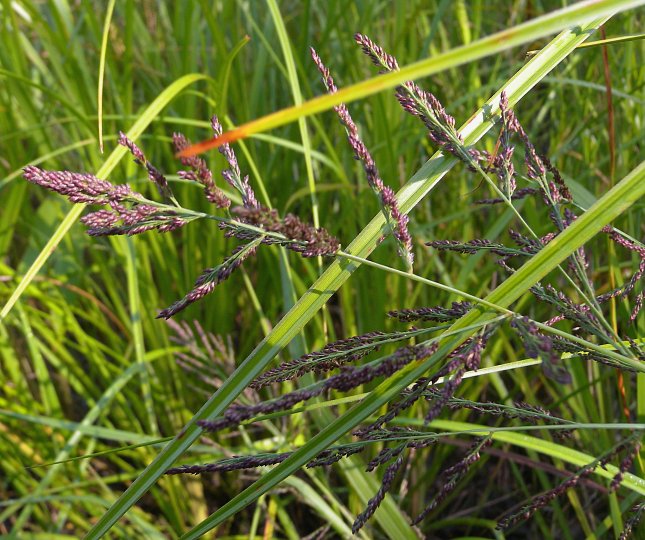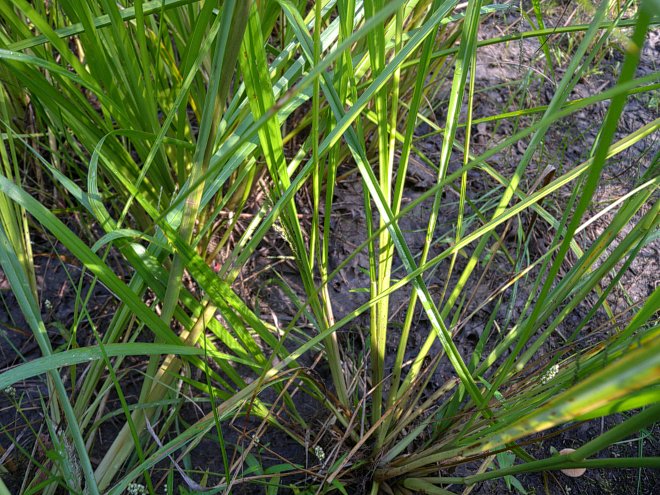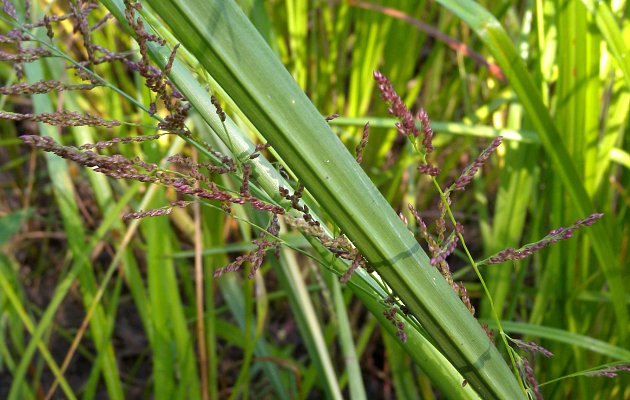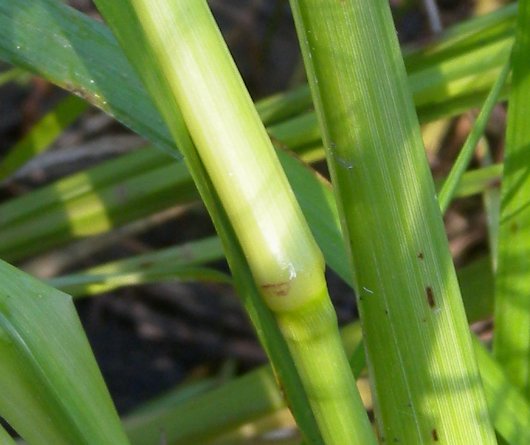Redtop Panic Grass
Coleataenia rigidula
Grass family (Poaceae)
Coleataenia rigidula
Grass family (Poaceae)
Description:
This perennial grass produces a loose tuft of erect to ascending leafy
culms about 1½–3¼' long. The culms are light green to straw-colored,
hairless, terete to slightly flattened, and unbranched. Alternate
leaves occur along the entire length of each culm below the
inflorescence. The arching to ascending leaf blades are up to 20" (50
cm.) long
and ½" (12 mm.) across; they are medium green, hairless (or nearly so),
and linear in shape, becoming folded near their bases with
upturned margins. Sometimes each leaf blade has a narrow ridge along
the middle of its underside. The leaf sheaths are light-medium green,
vertically veined, somewhat compressed, rather loose, and hairless
(or nearly so). The ligules are ragged-membranous; sometimes there are
a few hairs nearby. The nodes along the
culms are slightly swollen and hairless. Each fertile culm terminates
in a pyramidal panicle of spikelets that is up to 20" (50 cm.) long and
about one-half
as much across. This panicle has a central axis with lateral branches
that are spreading to ascending; the panicle also has secondary
branches with pediceled spikelets that originate from the lateral
branches and tend to be aligned with them. The central axis, branches,
and pedicels of the inflorescence
are light to medium green, narrowly terete, and hairless to minutely
appressed-pilose.

Solitary spikelets occur on short pedicels; they are often arranged together in a row along one side of the branches. Immature spikelets are light to medium reddish purple, but they become stramineus (straw-colored) with age. Each spikelet is about 2 mm. long with a short-ellipsoid shape, consisting of 2 glumes, 1 sterile lemma, and 1 fertile lemma. The shorter glume is about 1 mm. long, short-elliptic in shape, faintly 3-veined, and convex along its outer side. The longer glume is about 2 mm. long, short-elliptic in shape, faintly 5-veined, and convex along its outer side. The sterile lemma is about 2 mm. long, short-elliptic in shape, and convex along its outer side. The fertile lemma is about 1.5 mm. long with a perfect floret. In addition to the terminal panicle of spikelets, axillary panicles of spikelets are often produced from the axils of the leaves, from which they are short-exserted. These axillary panicles are usually smaller in size than the terminal panicle, otherwise they have similar characteristics. The blooming period occurs from late summer to early autumn, lasting about 1 month for a colony of plants. However, individual florets remain in bloom for about 1 week only; they are cross-pollinated by the wind. Afterwards, individual spikelets produce solitary grains. Individual grains are 1–1.5 mm. long, ellipsoid in shape, and about one-half as much across as they are long. The root system consists of a short-crown with fibrous roots; neither rhizomes nor stolons are produced. This grass reproduces by reseeding itself. It occasionally forms semi-open colonies of plants in favorable habitats.

Cultivation: The preference is full or partial sun, wet to consistently moist conditions, and either sandy or non-sandy soil containing an abundance of decayed organic matter. Most growth and development occurs during the late spring and summer. Standing water is tolerated if it is temporary.
Range & Habitat: The native Redtop Panic Grass (Coleataenia rigidula) is occasional in southern Illinois, uncommon in central Illinois, and rare or absent in northern Illinois (see Distribution Map). This grass is widely distributed in the eastern United States, especially along the Atlantic and Gulf of Mexico coastal areas and the lower to central Mississippi Valley. It also occurs in a few places in states along the Pacific Coast, where it is rare, and also in Central America, including Mexico. Illinois lies along the northern range-limit of this grass. Habitats include wet prairies, wet sand prairies, edges of sandy and non-sandy marshes, low areas along ponds, floodplain woodlands along rivers, swamps, and ditches. In Illinois, this grass is usually found in higher quality wetland areas.

Faunal Associations: A seed bug, Ischnodemus slossoni, has been observed to feed on Redtop Panic Grass (Coleataenia rigidula); see Hoffman (1996). This grass may also be a secondary host plant of a plant bug, Porpomiris curtulus, which feeds primarily on the more common Switchgrass (Panicum virgatum); see Wheeler & Schwartz (2018). More broadly, panic grasses (Panicum spp., Dichanthelium spp., Coleataenia spp.) are host plants for a variety of insects, including aphids, mealybugs, stink bugs, the larvae of some kinds of flies, and the larvae of some moths and skippers (see Insect Table). The larvae of a butterfly, the Northern Pearly Eye (Lethe anthedon), has also been observed to feed on the foliage of panic grasses. Among vertebrate animals, the seeds of panic grasses are eaten by such birds as the Swamp Sparrow, Bobolink, Redwing Blackbird, Sora, Mallard, and other ducks (see Bird Table); they are also eaten by some mice (Whitaker, 1966). The young foliage of these grasses is edible to horses, cattle, and other hoofed mammalian herbivores. The rather tall foliage of Redtop Panic Grass and other large panic grasses provide cover for birds, mammals, and other wildlife.
Photographic Location: A semi-shaded area near a sandy marsh at Bonnie's Prairie Nature Preserve in Iroquois County, Illinois.

Comments: This grass produces an attractive inflorescence of reddish purple spikelets, causing it to superficially resemble the more common grass, Purpletop (Tridens flavus cupreus). However, Redtop Panic Grass (Coleataenia rigidula) produces its inflorescence a little later in the year. Redtop Panic Grass has a history of taxonomic instability. Other scientific names that are sometimes used for this grass include Panicum rigidulum, Panicum longifolium, Panicum agrostoides, and Coleataenia longifolia rigidula (Mohlenbrock, 1986; KEW Grass Database; Hitchcock, 1950/1971; ITIS). The scientific name that is used here, Coleataenia rigidula, is from Mohlenbrock (2002). Mohlenbrock also refers to this grass as 'Munro Grass.' Redtop Panic Grass can be distinguished from other similar panic grasses (Panicum spp., Coleataenia spp.) by its showy purplish spikelets, the tendency of its spikelets to form one-sided rows in its inflorescence, the length of its spikelets (about 2 mm. long) and their shape (short-ellipsoid), the rather large leaf blades (up to ½" or 12 mm. across), the rather loose and compressed sheaths of its lower leaves, the largely hairless foliage, the lack of rhizomes and stolons, and its strong preference for wetland habitats.

Solitary spikelets occur on short pedicels; they are often arranged together in a row along one side of the branches. Immature spikelets are light to medium reddish purple, but they become stramineus (straw-colored) with age. Each spikelet is about 2 mm. long with a short-ellipsoid shape, consisting of 2 glumes, 1 sterile lemma, and 1 fertile lemma. The shorter glume is about 1 mm. long, short-elliptic in shape, faintly 3-veined, and convex along its outer side. The longer glume is about 2 mm. long, short-elliptic in shape, faintly 5-veined, and convex along its outer side. The sterile lemma is about 2 mm. long, short-elliptic in shape, and convex along its outer side. The fertile lemma is about 1.5 mm. long with a perfect floret. In addition to the terminal panicle of spikelets, axillary panicles of spikelets are often produced from the axils of the leaves, from which they are short-exserted. These axillary panicles are usually smaller in size than the terminal panicle, otherwise they have similar characteristics. The blooming period occurs from late summer to early autumn, lasting about 1 month for a colony of plants. However, individual florets remain in bloom for about 1 week only; they are cross-pollinated by the wind. Afterwards, individual spikelets produce solitary grains. Individual grains are 1–1.5 mm. long, ellipsoid in shape, and about one-half as much across as they are long. The root system consists of a short-crown with fibrous roots; neither rhizomes nor stolons are produced. This grass reproduces by reseeding itself. It occasionally forms semi-open colonies of plants in favorable habitats.

Cultivation: The preference is full or partial sun, wet to consistently moist conditions, and either sandy or non-sandy soil containing an abundance of decayed organic matter. Most growth and development occurs during the late spring and summer. Standing water is tolerated if it is temporary.
Range & Habitat: The native Redtop Panic Grass (Coleataenia rigidula) is occasional in southern Illinois, uncommon in central Illinois, and rare or absent in northern Illinois (see Distribution Map). This grass is widely distributed in the eastern United States, especially along the Atlantic and Gulf of Mexico coastal areas and the lower to central Mississippi Valley. It also occurs in a few places in states along the Pacific Coast, where it is rare, and also in Central America, including Mexico. Illinois lies along the northern range-limit of this grass. Habitats include wet prairies, wet sand prairies, edges of sandy and non-sandy marshes, low areas along ponds, floodplain woodlands along rivers, swamps, and ditches. In Illinois, this grass is usually found in higher quality wetland areas.

Faunal Associations: A seed bug, Ischnodemus slossoni, has been observed to feed on Redtop Panic Grass (Coleataenia rigidula); see Hoffman (1996). This grass may also be a secondary host plant of a plant bug, Porpomiris curtulus, which feeds primarily on the more common Switchgrass (Panicum virgatum); see Wheeler & Schwartz (2018). More broadly, panic grasses (Panicum spp., Dichanthelium spp., Coleataenia spp.) are host plants for a variety of insects, including aphids, mealybugs, stink bugs, the larvae of some kinds of flies, and the larvae of some moths and skippers (see Insect Table). The larvae of a butterfly, the Northern Pearly Eye (Lethe anthedon), has also been observed to feed on the foliage of panic grasses. Among vertebrate animals, the seeds of panic grasses are eaten by such birds as the Swamp Sparrow, Bobolink, Redwing Blackbird, Sora, Mallard, and other ducks (see Bird Table); they are also eaten by some mice (Whitaker, 1966). The young foliage of these grasses is edible to horses, cattle, and other hoofed mammalian herbivores. The rather tall foliage of Redtop Panic Grass and other large panic grasses provide cover for birds, mammals, and other wildlife.
Photographic Location: A semi-shaded area near a sandy marsh at Bonnie's Prairie Nature Preserve in Iroquois County, Illinois.

Comments: This grass produces an attractive inflorescence of reddish purple spikelets, causing it to superficially resemble the more common grass, Purpletop (Tridens flavus cupreus). However, Redtop Panic Grass (Coleataenia rigidula) produces its inflorescence a little later in the year. Redtop Panic Grass has a history of taxonomic instability. Other scientific names that are sometimes used for this grass include Panicum rigidulum, Panicum longifolium, Panicum agrostoides, and Coleataenia longifolia rigidula (Mohlenbrock, 1986; KEW Grass Database; Hitchcock, 1950/1971; ITIS). The scientific name that is used here, Coleataenia rigidula, is from Mohlenbrock (2002). Mohlenbrock also refers to this grass as 'Munro Grass.' Redtop Panic Grass can be distinguished from other similar panic grasses (Panicum spp., Coleataenia spp.) by its showy purplish spikelets, the tendency of its spikelets to form one-sided rows in its inflorescence, the length of its spikelets (about 2 mm. long) and their shape (short-ellipsoid), the rather large leaf blades (up to ½" or 12 mm. across), the rather loose and compressed sheaths of its lower leaves, the largely hairless foliage, the lack of rhizomes and stolons, and its strong preference for wetland habitats.